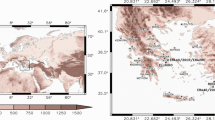Summary
This paper is a contribution to experimental meteorology: A sea-breeze front was investigated by aircraft observations and thorough numerical analysis using an unprecedented number of runs crossing the same front within a timespan of . The 33 runs were flown in a situation of offshore geostrophic wind of 5 m/s in 1000 hPa and with the strategy of obtaining information on the four-dimensional field (t=time, x=cross-coastal coordinate, y=coast-parallel coordinate, z=height): 9 runs in x-direction (and reverse) at different heights to yield x,z-cross-sections of the observed meteorological quantities (specific humidity q, potential temperature Θ and the components u, v and w of the wind velocity), assuming a frozen structure in time; the next 7 runs again in x-direction but all at the same level and on the same track to yield x,t-diagrams of the same quantities in order to study the temporal changes compared to those with x and z; the next 10 runs as a zig-zagging flight track crossing the front but drifting in y-direction, all at the same height, in order to obtain the y-dependency; andfinally 7 runs for another x,z-cross-sectional analysis, which can be compared to that evaluated from the runs at the beginning of the mission.
The paper describes the 4-dimensional dependencies in detail. Pure x-variations at constant z are expressed by VCM low-pass filtered space series (VCM=variance conserving multiresolution, according to Howell and Mahrt, 1994). The x,z-analyses are similar to those in Kraus et al. (1990) and Finkele et al. (1995) verifying these results. The comparison of the x,z-studies gained from the data at the beginning and at the end of the mission show how the sea-breeze frontal area changes its structure. The fluctuations (in time) revealed by the low-pass filtered x,t-runs (same track and same height) are smaller than the contour intervals chosen in the x,z-cross-sections. This shows, that the single runs, from which the x,z-cross-sections are constructed, reliably and significantly contribute to the interpolated structure. The paper also demonstrates the overall development of the front within the 31/2 h of continuous observation. The x,y-fields demonstrate that the y-dependency of the various quantities is generally one order of magnitude smaller than the x-dependency and that the assumption of negligible y-dependency holds in the first order of approximation for a fairly homogeneous coast. Convective disturbances of a horizontal scale of 1 to 4 km at the landward side of the front, embedded in the offshore flow and bouncing against the landward propagating sea-breeze front, considerably contribute to variations of the frontal propagation speed and of the frontal shape and also to changes of the parameters with the along-frontal coordinate y.
Similar content being viewed by others
Author information
Authors and Affiliations
Additional information
Received April 24, 1998 Revised November 3, 1998
Rights and permissions
About this article
Cite this article
Stephan, K., Kraus, H., Ewenz, C. et al. Sea-breeze Front Variations in Space and Time. Meteorol Atmos Phys 70, 81–95 (1999). https://doi.org/10.1007/s007030050026
Issue Date:
DOI: https://doi.org/10.1007/s007030050026




